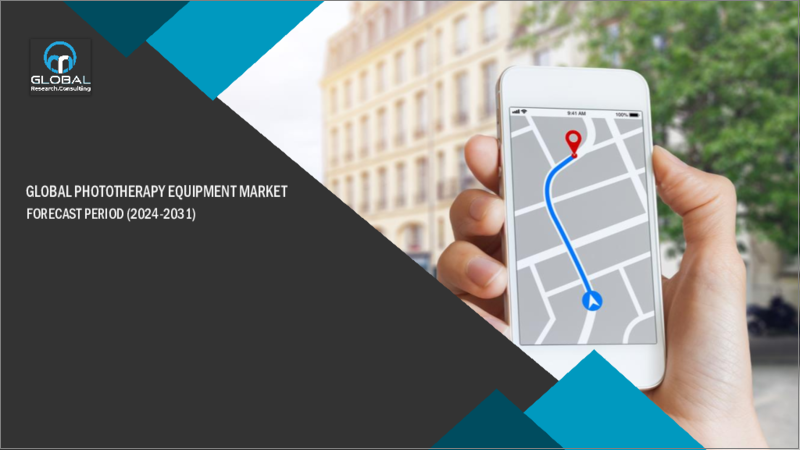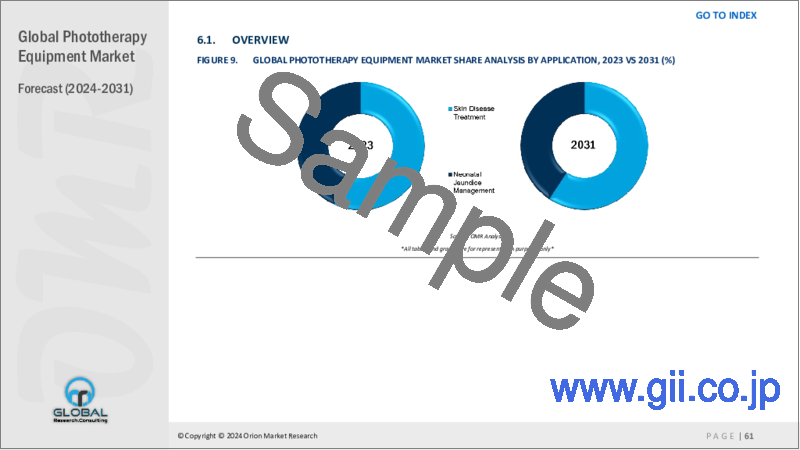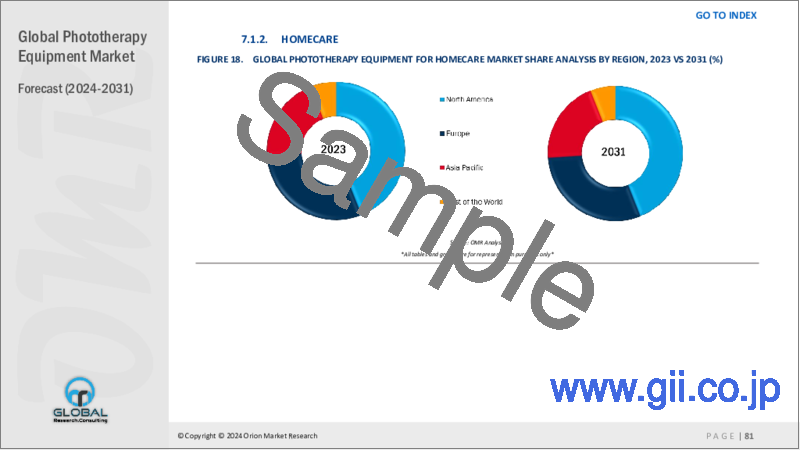|
|
市場調査レポート
商品コード
1380263
光線療法機器の世界市場:2023年~2030年Global Phototherapy Equipment Market 2023-2030 |
||||||
カスタマイズ可能
|
|||||||
| 光線療法機器の世界市場:2023年~2030年 |
|
出版日: 2023年09月26日
発行: Orion Market Research
ページ情報: 英文 240 Pages
納期: 2~3営業日
|
- 全表示
- 概要
- 図表
- 目次
世界の光線療法装置市場は、予測期間(2023年~2030年)にCAGR 5.2%で成長すると予測されています。これは、皮膚疾患の有病率の増加、新生児黄疸の発生率の上昇、光線療法分野における継続的な技術進歩、LEDベースの光線療法装置の採用によるものです。光線療法機器は、菌状息肉症、乾癬、モルフェア、白斑などの様々な皮膚関連疾患の治療に使用されます。
セグメント別の展望
皮膚疾患治療のサブセグメントが光線治療装置の世界市場でかなりのシェアを占めると予想されます。
用途別では、皮膚疾患治療のサブセグメントが世界の光線療法装置市場でかなりのシェアを占めると予想されています。光線療法は、様々な皮膚疾患に対する非常に効果的な治療法です。光線療法は、特定の波長の光を用いて炎症を抑え、皮膚細胞の増殖を遅らせ、治癒を改善します。光線療法は、外科的処置や薬剤投与を必要としない非侵襲的な治療法です。そのため、非薬物療法を好む人や、特定の薬剤を服用できない人に適した治療法です。光線療法はまた、亢進した免疫反応を抑制することにより、乾癬に伴う発赤、腫脹、かゆみを軽減します。
米国、中国、インドなどの国々で皮膚疾患が増加していることが、光線療法装置の使用増加の原因となっています。全米乾癬財団によると、乾癬性疾患は米国で800万人以上、世界で1億2,500万人以上に影響を及ぼしています。両親のどちらかが乾癬の場合、子供が乾癬を発症する確率は約28%であるため、遺伝は非常に重要です。両親ともに乾癬の場合、子供が乾癬になる確率は約65%です。白斑や円形脱毛症などの自己免疫性皮膚疾患では、免疫系が誤って健康な細胞を攻撃し、色素脱失や脱毛を引き起こします。光線療法は免疫反応を修正し、組織に対する身体の攻撃を低下させるのに役立ちます。
地域別展望
世界の光線療法装置市場は、北米(米国、カナダ)、欧州(英国、イタリア、スペイン、ドイツ、フランス、その他欧州地域)、アジア太平洋地域(インド、中国、日本、韓国、その他アジア地域)、その他の地域(中東とアフリカ、ラテンアメリカ)を含む地域別にさらに細分化されています。なかでも北米は、新生児黄疸や皮膚疾患の発生が増加していること、また新技術の利用に対する人々の意識が高まっていることから、全世界で突出したシェアを占めると予想されます。
アジア太平洋地域は世界の光線療法装置市場において著しいCAGRで成長する見込み
すべての地域の中で、アジア太平洋地域は、効果的なヘルスケアソリューションを提供するための病院や専門クリニックの建設が増加しているため、予測期間中にかなりのCAGRで成長すると予想されています。これとは別に、大衆の間でのヘルスケア支出の増加が市場の成長に寄与しています。2019年、中国のヘルスケア輸出入量はともに増加し、2011年以来の高水準に達しました。欧州、アジア、北米は、中国のヘルスケア対外貿易の上位3大陸パートナーでした。中国のこの分野を形成している主な要因と推進力、特に重要な開発計画や規制を発行する中国政府の役割がますます支援的になっていること、また急速に高齢化が進む中国の人口。中国の医薬品産業は着実に拡大しており、2023年末には1,618億米ドルに達し、世界市場の約30%を占めると予測されています。しかし、中国のトップ製薬企業や多国籍多国籍製薬企業(米国を含む)が市場の大半の売上を独占しているため、米国の中小製薬企業が進出するチャンスは限られています。
目次
第1章 レポート概要
- 業界の現状分析と成長ポテンシャルの展望
- 調査方法とツール
- 市場内訳
- セグメント別
- 地域別
第2章 市場概要と洞察
- 調査範囲
- アナリストの洞察と現在の市場動向
- 主な調査結果
- 推奨事項
- 結論
第3章 競合情勢
- 主要企業分析
- 概要
- 財務分析
- SWOT分析
- 最近の動向
- 主要戦略分析
第4章 市場セグメンテーション
- 光線療法装置の世界市場:製品別
- 従来型光線療法装置
- LED光線療法装置
- 光ファイバー光線療法装置
- 光線治療装置の世界市場:用途別
- 皮膚疾患治療
- 菌状息肉症
- 乾癬
- 白斑
- その他(湿疹、円形脱毛症)
- 新生児黄疸管理
- 皮膚疾患治療
- 光線療法装置の世界市場:エンドユーザー別
- 病院・クリニック
- ホームケア
第5章 地域別分析
- 北米
- 米国
- カナダ
- 欧州
- 英国
- ドイツ
- イタリア
- スペイン
- フランス
- その他の欧州
- アジア太平洋
- 中国
- インド
- 日本
- 韓国
- その他のアジア太平洋
- その他の地域
第6章 企業プロファイル
- Aeroflow, Inc.
- Alfamedic s. r. o.
- Atom Medical Corporation
- GE HealthCare
- Herbert Waldmann GmbH & Co. KG
- Hill-Rom Holdings, Inc.
- Medela AG
- National Biological Corporation
- Natus Medical Inc.
- Nice Neotech Medical Systems Pvt. Ltd.
- Philips Lighting Holding B.V.
- Phoenix Medical Systems
- Signify Holding
- Solarc Systems Inc.
- SS TECHNOMED(P)LTD.
- The Daavlin Company
LIST OF TABLES
- 1. GLOBAL PHOTOTHERAPY EQUIPMENT MARKET RESEARCH AND ANALYSIS BY PRODUCT, 2022-2030 ($ MILLION)
- 2. GLOBAL CONVENTIONAL PHOTOTHERAPY EQUIPMENT MARKET RESEARCH AND ANALYSIS BY REGION, 2022-2030 ($ MILLION)
- 3. GLOBAL LED PHOTOTHERAPY EQUIPMENT MARKET RESEARCH AND ANALYSIS BY REGION, 2022-2030 ($ MILLION)
- 4. GLOBAL FIBER OPTIC PHOTOTHERAPY EQUIPMENT MARKET RESEARCH AND ANALYSIS BY REGION, 2022-2030 ($ MILLION)
- 5. GLOBAL PHOTOTHERAPY EQUIPMENT MARKET RESEARCH AND ANALYSIS BY APPLICATION, 2022-2030 ($ MILLION)
- 6. GLOBAL PHOTOTHERAPY EQUIPMENT FOR SKIN DISEASE TREATMENT MARKET RESEARCH AND ANALYSIS BY REGION, 2022-2030 ($ MILLION)
- 7. GLOBAL PHOTOTHERAPY EQUIPMENT FOR MYCOSIS FUNGOIDES MARKET RESEARCH AND ANALYSIS BY REGION, 2022-2030 ($ MILLION)
- 8. GLOBAL PHOTOTHERAPY EQUIPMENT FOR PSORIASIS MARKET RESEARCH AND ANALYSIS BY REGION, 2022-2030 ($ MILLION)
- 9. GLOBAL PHOTOTHERAPY EQUIPMENT FOR VITILIGO MARKET RESEARCH AND ANALYSIS BY REGION, 2022-2030 ($ MILLION)
- 10. GLOBAL PHOTOTHERAPY EQUIPMENT FOR OTHER SKIN DISEASE TREATMENT MARKET RESEARCH AND ANALYSIS BY REGION, 2022-2030 ($ MILLION)
- 11. GLOBAL PHOTOTHERAPY EQUIPMENT FOR NEONATAL JAUNDICE MANAGEMENT MARKET RESEARCH AND ANALYSIS BY REGION, 2022-2030 ($ MILLION)
- 12. GLOBAL PHOTOTHERAPY EQUIPMENT MARKET RESEARCH AND ANALYSIS BY END-USER, 2022-2030 ($ MILLION)
- 13. GLOBAL PHOTOTHERAPY EQUIPMENT FOR HOSPITALS AND CLINICS MARKET RESEARCH AND ANALYSIS BY REGION, 2022-2030 ($ MILLION)
- 14. GLOBAL PHOTOTHERAPY EQUIPMENT FOR HOMECARE MARKET RESEARCH AND ANALYSIS BY REGION, 2022-2030 ($ MILLION)
- 15. GLOBAL PHOTOTHERAPY EQUIPMENT MARKET RESEARCH AND ANALYSIS BY REGION, 2022-2030 ($ MILLION)
- 16. NORTH AMERICAN PHOTOTHERAPY EQUIPMENT MARKET RESEARCH AND ANALYSIS BY COUNTRY, 2022-2030 ($ MILLION)
- 17. NORTH AMERICAN PHOTOTHERAPY EQUIPMENT MARKET RESEARCH AND ANALYSIS BY PRODUCT, 2022-2030 ($ MILLION)
- 18. NORTH AMERICAN PHOTOTHERAPY EQUIPMENT MARKET RESEARCH AND ANALYSIS BY APPLICATION, 2022-2030 ($ MILLION)
- 19. NORTH AMERICAN PHOTOTHERAPY EQUIPMENT MARKET RESEARCH AND ANALYSIS BY END-USER, 2022-2030 ($ MILLION)
- 20. EUROPEAN PHOTOTHERAPY EQUIPMENT MARKET RESEARCH AND ANALYSIS BY COUNTRY, 2022-2030 ($ MILLION)
- 21. EUROPEAN PHOTOTHERAPY EQUIPMENT MARKET RESEARCH AND ANALYSIS BY PRODUCT, 2022-2030 ($ MILLION)
- 22. EUROPEAN PHOTOTHERAPY EQUIPMENT MARKET RESEARCH AND ANALYSIS BY APPLICATION, 2022-2030 ($ MILLION)
- 23. EUROPEAN PHOTOTHERAPY EQUIPMENT MARKET RESEARCH AND ANALYSIS BY END-USER, 2022-2030 ($ MILLION)
- 24. ASIA-PACIFIC PHOTOTHERAPY EQUIPMENT MARKET RESEARCH AND ANALYSIS BY COUNTRY, 2022-2030 ($ MILLION)
- 25. ASIA-PACIFIC PHOTOTHERAPY EQUIPMENT MARKET RESEARCH AND ANALYSIS BY PRODUCT, 2022-2030 ($ MILLION)
- 26. ASIA-PACIFIC PHOTOTHERAPY EQUIPMENT MARKET RESEARCH AND ANALYSIS BY APPLICATION, 2022-2030 ($ MILLION)
- 27. ASIA-PACIFIC PHOTOTHERAPY EQUIPMENT MARKET RESEARCH AND ANALYSIS BY END-USER, 2022-2030 ($ MILLION)
- 28. REST OF THE WORLD PHOTOTHERAPY EQUIPMENT MARKET RESEARCH AND ANALYSIS BY REGION, 2022-2030 ($ MILLION)
- 29. REST OF THE WORLD PHOTOTHERAPY EQUIPMENT MARKET RESEARCH AND ANALYSIS BY PRODUCT, 2022-2030 ($ MILLION)
- 30. REST OF THE WORLD PHOTOTHERAPY EQUIPMENT MARKET RESEARCH AND ANALYSIS BY APPLICATION, 2022-2030 ($ MILLION)
- 31. REST OF THE WORLD PHOTOTHERAPY EQUIPMENT MARKET RESEARCH AND ANALYSIS BY END-USER, 2022-2030 ($ MILLION)
LIST OF FIGURES
- 1. GLOBAL PHOTOTHERAPY EQUIPMENT MARKET SHARE BY PRODUCT, 2022 VS 2030 (%)
- 2. GLOBAL CONVENTIONAL PHOTOTHERAPY EQUIPMENT MARKET SHARE BY REGION, 2022 VS 2030 (%)
- 3. GLOBAL LED PHOTOTHERAPY EQUIPMENT MARKET SHARE BY REGION, 2022 VS 2030 (%)
- 4. GLOBAL PHOTOTHERAPY EQUIPMENT MARKET SHARE BY APPLICATION, 2022 VS 2030 (%)
- 5. GLOBAL PHOTOTHERAPY EQUIPMENT FOR SKIN DISEASE TREATMENT MARKET SHARE BY REGION, 2022 VS 2030 (%)
- 6. GLOBAL PHOTOTHERAPY EQUIPMENT FOR MYCOSIS FUNGOIDES MARKET SHARE BY REGION, 2022 VS 2030 (%)
- 7. GLOBAL PHOTOTHERAPY EQUIPMENT FOR PSORIASIS MARKET SHARE BY REGION, 2022 VS 2030 (%)
- 8. GLOBAL PHOTOTHERAPY EQUIPMENT FOR VITILIGO MARKET SHARE BY REGION, 2022 VS 2030 (%)
- 9. GLOBAL PHOTOTHERAPY EQUIPMENT FOR OTHER SKIN DISEASE TREATMENT MARKET SHARE BY REGION, 2022 VS 2030 (%)
- 10. GLOBAL PHOTOTHERAPY EQUIPMENT FOR NEONATAL JAUNDICE MANAGEMENT MARKET SHARE BY REGION, 2022 VS 2030 (%)
- 11. GLOBAL PHOTOTHERAPY EQUIPMENT MARKET SHARE BY END-USER, 2022 VS 2030 (%)
- 12. GLOBAL PHOTOTHERAPY EQUIPMENT FOR HOSPITALS AND CLINICS MARKET SHARE BY REGION, 2022 VS 2030 (%)
- 13. GLOBAL PHOTOTHERAPY EQUIPMENT FOR HOMECARE MARKET SHARE BY REGION, 2022 VS 2030 (%)
- 14. GLOBAL PHOTOTHERAPY EQUIPMENT MARKET SHARE BY REGION, 2022 VS 2030 (%)
- 15. US PHOTOTHERAPY EQUIPMENT MARKET SIZE, 2022-2030 ($ MILLION)
- 16. CANADA PHOTOTHERAPY EQUIPMENT MARKET SIZE, 2022-2030 ($ MILLION)
- 17. UK PHOTOTHERAPY EQUIPMENT MARKET SIZE, 2022-2030 ($ MILLION)
- 18. FRANCE PHOTOTHERAPY EQUIPMENT MARKET SIZE, 2022-2030 ($ MILLION)
- 19. GERMANY PHOTOTHERAPY EQUIPMENT MARKET SIZE, 2022-2030 ($ MILLION)
- 20. ITALY PHOTOTHERAPY EQUIPMENT MARKET SIZE, 2022-2030 ($ MILLION)
- 21. SPAIN PHOTOTHERAPY EQUIPMENT MARKET SIZE, 2022-2030 ($ MILLION)
- 22. REST OF EUROPE PHOTOTHERAPY EQUIPMENT MARKET SIZE, 2022-2030 ($ MILLION)
- 23. INDIA PHOTOTHERAPY EQUIPMENT MARKET SIZE, 2022-2030 ($ MILLION)
- 24. CHINA PHOTOTHERAPY EQUIPMENT MARKET SIZE, 2022-2030 ($ MILLION)
- 25. JAPAN PHOTOTHERAPY EQUIPMENT MARKET SIZE, 2022-2030 ($ MILLION)
- 26. SOUTH KOREA PHOTOTHERAPY EQUIPMENT MARKET SIZE, 2022-2030 ($ MILLION)
- 27. REST OF ASIA-PACIFIC PHOTOTHERAPY EQUIPMENT MARKET SIZE, 2022-2030 ($ MILLION)
- 28. REST OF THE WORLD PHOTOTHERAPY EQUIPMENT MARKET SIZE, 2022-2030 ($ MILLION)
Title: Global Phototherapy Equipment Market Size, Share & Trends Analysis Report by Product (Conventional Phototherapy Equipment, LED Phototherapy Equipment, and Fiber Optic Phototherapy Equipment), by Application (Skin Disease Treatment and Neonatal Jaundice Management), and by End-user (Hospitals, Clinics and Homecare),Forecast Period (2023-2030).
Global phototherapy equipment market is anticipated to grow at a CAGR of 5.2% during the Forecast Period (2023-2030). owing to increase in the prevalence of skin diseases, rise in incidence of neonatal jaundice, continuous technological advancements in the area of phototherapy, and adoption of LED-based phototherapy equipment. Phototherapy equipment is used for the treatment of various skin-related diseases such as mycosis fungoides, psoriasis, morphea, vitiligo, and others.
Segmental Outlook
The global phototherapy equipment market is segmented by product, application, and end-user. Based on the product, the market is sub-segmented into conventional phototherapy equipment, led phototherapy equipment, and fiber optic phototherapy equipment. Based on the application, the market is sub-segmented into skin disease treatment and neonatal jaundice management. Further, based on end-users, the market is sub-segmented into hospitals, clinics, and home care. Among the products, the LED phototherapy equipment sub-segment is anticipated to hold a considerable share of the market. LED-based phototherapy is used to treat skin diseases such as fine lines, psoriasis, and acne. The rise in the number of people suffering from such skin conditions is expected to boost the demand for LED-based phototherapy devices. Acne is the most common skin condition that people experience. An estimated 80% of people ages 11 to 30 will have at least a mild form of acne making it the eighth most prevalent disease worldwide.
The Skin Disease Treatment Sub-Segment is Anticipated to Hold a Considerable Share of the Global Phototherapy Equipment Market
Among the applications, the skin disease treatment sub-segment is expected to hold a considerable share of the global phototherapy equipment market. Phototherapy is a highly effective therapy for a variety of skin diseases. Phototherapy uses specific wavelengths of light to reduce inflammation, slow skin cell proliferation, and improve healing. Phototherapy is a non-invasive treatment option that does not require surgical procedures or the administration of drugs. This makes it a good choice for people who prefer non-pharmacological treatments or who cannot take certain medications. Phototherapy also reduces the redness, swelling, and itching associated with psoriasis by suppressing the hyperactive immune response.
Increasing skin diseases in countries such as the US, China, and India have accounted for the rise in the use of phototherapy equipment. According to the National Psoriasis Foundation, Psoriatic disease impacts more than 8 million people in the US and 125 million people globally. Genetics are crucial because if one parent has psoriasis, a child has about a 28% chance of developing psoriasis. If both parents have psoriasis, a child has approximately a 65% chance of developing psoriasis. The immune system mistakenly assaults healthy cells in autoimmune skin illnesses such as vitiligo and alopecia areata, resulting in depigmentation or hair loss. Phototherapy can help modify the immune response, lowering the body's attack on tissues.
Regional Outlook
The global phototherapy equipment market is further segmented based on geography including North America (the US, and Canada), Europe (UK, Italy, Spain, Germany, France, and the Rest of Europe), Asia-Pacific (India, China, Japan, South Korea, and Rest of Asia), and the Rest of the World (the Middle East & Africa, and Latin America. Among these, North America is anticipated to hold a prominent share of the market across the globe, owing to the rising occurrence of neonatal jaundice and skin diseases and increasing awareness among the people towards the use of new technologies.
The Asia-Pacific Region is Expected to Grow at a Significant CAGR in the Global Phototherapy Equipment Market
Among all regions, the Asia-Pacific region is anticipated to grow at a considerable CAGR over the forecast period due to the rising construction of hospitals and specialized clinics to offer effective healthcare solutions. Apart from this, the increasing healthcare expenditure among the masses is contributing to the growth of the market. In 2019, China's healthcare import and export volumes both saw an increase, reaching the highest levels since 2011. Europe, Asia, and North America were China's top three continental partners for healthcare foreign trade. Major factors and drivers that are shaping the sector in China, especially the increasingly supporting role of the Chinese government in issuing key development plans and regulations, as well as the rapidly aging Chinese population. China's pharmaceutical industry has been steadily expanding and is predicted to reach $161.8 billion by the end of 2023, accounting for around 30% of the worldwide market. However, because top Chinese pharmaceutical businesses and multinational MNC pharmaceutical companies (including those from the US) have dominated most market sales, chances for US SME pharmaceutical companies to explore are restricted.
Market Players Outlook
The major companies serving the phototherapy equipment market include: Daavlin Company, Aeroflow, Inc., Philips Lighting Holding B.V., Signify Holding, Atom Medical Corporation, Herbert Waldmann GmbH & Co. KG, Hill-Rom Holdings, Inc., and others. The market players are considerably contributing to the market growth by the adoption of various strategies including mergers and acquisitions, partnerships, collaborations, funding, and new product launches, to stay competitive in the market. For instance, in April 2022, Philips signed a long-term strategic partnership with Oulu University Hospital Finland to deliver advanced image-guided specialist care. They will all be equipped with Philips' image-guided therapy system Azurion with FlexArm an advanced image-guided therapy platform that offers the latest innovations to help physicians improve efficiency, workflow, and treatment outcomes.
The Report Covers:
- Market value data analysis of 2022 and forecast to 2030.
- Annualized market revenues ($ million) for each market segment.
- Country-wise analysis of major geographical regions.
- Key companies operating in the global phototherapy equipment market. Based on the availability of data, information related to new product launches, and relevant news is also available in the report.
- Analysis of business strategies by identifying the key market segments positioned for strong growth in the future.
- Analysis of market-entry and market expansion strategies.
- Competitive strategies by identifying 'who-stands-where' in the market.
Table of Contents
1. Report Summary
- Current Industry Analysis and Growth Potential Outlook
- 1.1. Research Methods and Tools
- 1.2. Market Breakdown
- 1.2.1. By Segments
- 1.2.2. By Region
2. Market Overview and Insights
- 2.1. Scope of the Report
- 2.2. Analyst Insight & Current Market Trends
- 2.2.1. Key Findings
- 2.2.2. Recommendations
- 2.2.3. Conclusion
3. Competitive Landscape
- 3.1. Key Company Analysis
- 3.1.1. Overview
- 3.1.2. Financial Analysis
- 3.1.3. SWOT Analysis
- 3.1.4. Recent Developments
- 3.2. Key Strategy Analysis
4. Market Segmentation
- 4.1. Global Phototherapy Equipment Market by Product
- 4.1.1. Conventional Phototherapy Equipment
- 4.1.2. LED Phototherapy Equipment
- 4.1.3. Fiber Optic Phototherapy Equipment
- 4.2. Global Phototherapy Equipment Market by Application
- 4.2.1. Skin Disease Treatment
- 4.2.1.1. Mycosis fungoides
- 4.2.1.2. Psoriasis
- 4.2.1.3. Vitiligo
- 4.2.1.4. Others (Eczema, Morphea)
- 4.2.2. Neonatal Jaundice Management
- 4.2.1. Skin Disease Treatment
- 4.3. Global Phototherapy Equipment Market by End-User
- 4.3.1. Hospitals & Clinics
- 4.3.2. Homecare
5. Regional Analysis
- 5.1. North America
- 5.1.1. United States
- 5.1.2. Canada
- 5.2. Europe
- 5.2.1. UK
- 5.2.2. Germany
- 5.2.3. Italy
- 5.2.4. Spain
- 5.2.5. France
- 5.2.6. Rest of Europe
- 5.3. Asia-Pacific
- 5.3.1. China
- 5.3.2. India
- 5.3.3. Japan
- 5.3.4. South Korea
- 5.3.5. Rest of Asia-Pacific
- 5.4. Rest of the World
6. Company Profiles
- 6.1. Aeroflow, Inc.
- 6.2. Alfamedic s. r. o.
- 6.3. Atom Medical Corporation
- 6.4. GE HealthCare
- 6.5. Herbert Waldmann GmbH & Co. KG
- 6.6. Hill-Rom Holdings, Inc.
- 6.7. Medela AG
- 6.8. National Biological Corporation
- 6.9. Natus Medical Inc.
- 6.10. Nice Neotech Medical Systems Pvt. Ltd.
- 6.11. Philips Lighting Holding B.V.
- 6.12. Phoenix Medical Systems
- 6.13. Signify Holding
- 6.14. Solarc Systems Inc.
- 6.15. SS TECHNOMED (P) LTD.
- 6.16. The Daavlin Company





